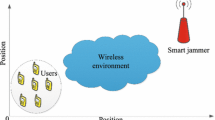Abstract
Massive MIMO(Multiple-Input Multiple-Output) technology is one of the most important physical layer technologies in 5 g and even 6G. In the process of wireless transmission, due to the complexity of the propagation environment, the signal is vulnerable to thousands of interference, resulting in the final received synthetic signal composed of standard signal and interference signal. With the development of science and technology, artificial intelligence has penetrated into signal processing and achieved good results. Multi user game theory in artificial intelligence algorithm is considered to be one of the most important theoretical achievements of Applied Mathematics in this century. The devices in the communication network interfere with each other and have a competitive relationship. To solve this problem, combined with the game theory of artificial intelligence algorithm, the equipment in the communication network is modeled as the players participating in the competition in the game theory, and the array factor of the base station transmitting antenna array is adjusted according to the channel conditions and service requirements of different equipment. In order to make the Nash equilibrium point converge, an array factor update algorithm is designed. Finally, the performance of the algorithm is verified in simulation.






Similar content being viewed by others
References
Wang M, Gao F, Shlezinger N, Flanagan MF, Eldar YC (2020) A block sparsity based estimator for mm wave massive MIMO channels with beam squint [J]. IEEE Trans Signal Process 68:49–64
Wang J, He L, Song J (2019) Towards higher spectral efficiency: Spatial path index modulation improves millimeter-wave hybrid beamforming[J]. IEEE J Select Top Signal Process 13(6):1348–1359
Bandi A, Joroughi V, Mysore BSR, Grotz J, Ottersten B (2018) Sparsity aided low-implementation cost based on-board beamforming design for high throughput satellite systems[C]. 2018 9th Advanced Satellite Multimedia Systems Conference and the 15th Signal Processing for Space Communications Workshop (ASMS/SPSC), pp 1–6
Guesmi L, Menif M (2015) Modulation formats recognition technique using artificial neural networks for radio over fiber systems[C]. 2015 17th International Conference on Transparent Optical Networks (ICTON), Budapest, pp 1–4
Ye H, Li GY, Juang B (2018) Power of deep learning for channel estimation and signal detection in OFDM systems[J]. IEEE Wireless Commun Lett 7(1):114–117
Ranjan R, Patel VM, Chellappa R (2019) Hyper face: a deep multi-task learning framework for face detection, landmark localization, pose estimation, and gender recognition[J]. IEEE Trans Pattern Anal Mach Intell 41(1):121–135
O’Shea T, Hoydis J (2017) An introduction to deep learning for the physical layer[J]. IEEE Trans Cogn Commun Netw 3(4):63–575
Huang H, Xia W, Xiong J, Yang J, Zheng G, Zhu X (2019) Unsupervised learning-based fast beamforming design for downlink MIMO[J]. IEEE Access 7:7599–7605
Huang H, Song Y, Yang J, Gui G, Adachi F (2019) Deep-learning-based millimeter-wave massive MIMO for hybrid precoding[J]. IEEE Trans Veh Technol 68(3):3027–3032
Lee W, Kim M, Cho D-H (2018) Deep power control: transmit power control scheme based on convolutional neural network[J]. IEEE Commun Lett 22(6):1276–1279
Kasbekar GS, Sarkar S (2016) Spectrum white space trade in cognitive radio networks. IEEE Trans Autom Control 61(3):585–600
Kumar KV, Prakash AJU, Tripathi RM (2017) A spectrum handoff scheme for optimal network selection in Cognitive Radio vehicular networks: a game theoretic auction theory approach. PhysicalCommunication 24(9):19–33
Ahmed IK, Fapojuwo AO (2018) Stackelberg equilibria of an anti-jamming game in cooperative cognitive radio networks. IEEE Trans Cogn Commun Netw 4(1):121–134
Silver D, Schrittwieser J, Simonyan K et al (2017) Mastering the game of go without human knowledge. Nature 550(7676):354–359
Brown N, Sandholm T (2019) Superhuman AI for multi player poker. Science 365(6456):885–890
Vinyals O, Babuschkin I, Czarnecki WM et al (2019) Grandmaster level in star craft ii using multi-agent reinforcement learning. Nature 575(7782):350–354
Li J, Koyamada S, Ye Q, et al (2003) Suphx: mastering mahjong with deep reinforcement learning. arXiv preprint arXiv 13590, 2020
Liu X, Zhang X (2019) Rate and energy efficiency improvements for 5G-based IoT with simultaneous transfer. IEEE Internet Things J 6(4):5971–5980
Choy J, Lee K, Oh S (2020) Sparse actor-critic: sparse tsallis entropy regularized reinforcement learningin a continuous action space. 17th International Conference on Ubiquitous Robots (UR). IEEE
Rusch T, Steixner-Kumar S, Doshi P et al (2020) Theory of mind and decision science: towards a typology of tasks and computational models. Neuropsychologia 146(211):107488
Liu X, Zhang X, Jia M et al (2018) 5G-based green broadband communication system design with simultaneous wireless information and power transfer. Phys Commun 28:130–137
Acknowledgements
This paper is supported by the Guangdong Province higher vocational colleges & schools Pearl River scholar funded scheme (2016),Research platform and project of Department of Education of Guangdong Province (2019GGCZX009), the Key laboratory of Longgang District (LGKCZSYS2018000028) and the Scientific and Technological Projects of Shenzhen (No.JCYJ20190808093001772).
Author information
Authors and Affiliations
Additional information
Publisher's Note
Springer Nature remains neutral with regard to jurisdictional claims in published maps and institutional affiliations.
Rights and permissions
About this article
Cite this article
Guan, M., Wu, Z., Yang, W. et al. Research on Anti-Jamming Algorithm of Massive MIMO Communication System Based on Multi-User Game Theory. Mobile Netw Appl 27, 1553–1558 (2022). https://doi.org/10.1007/s11036-021-01874-7
Accepted:
Published:
Issue Date:
DOI: https://doi.org/10.1007/s11036-021-01874-7




